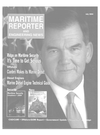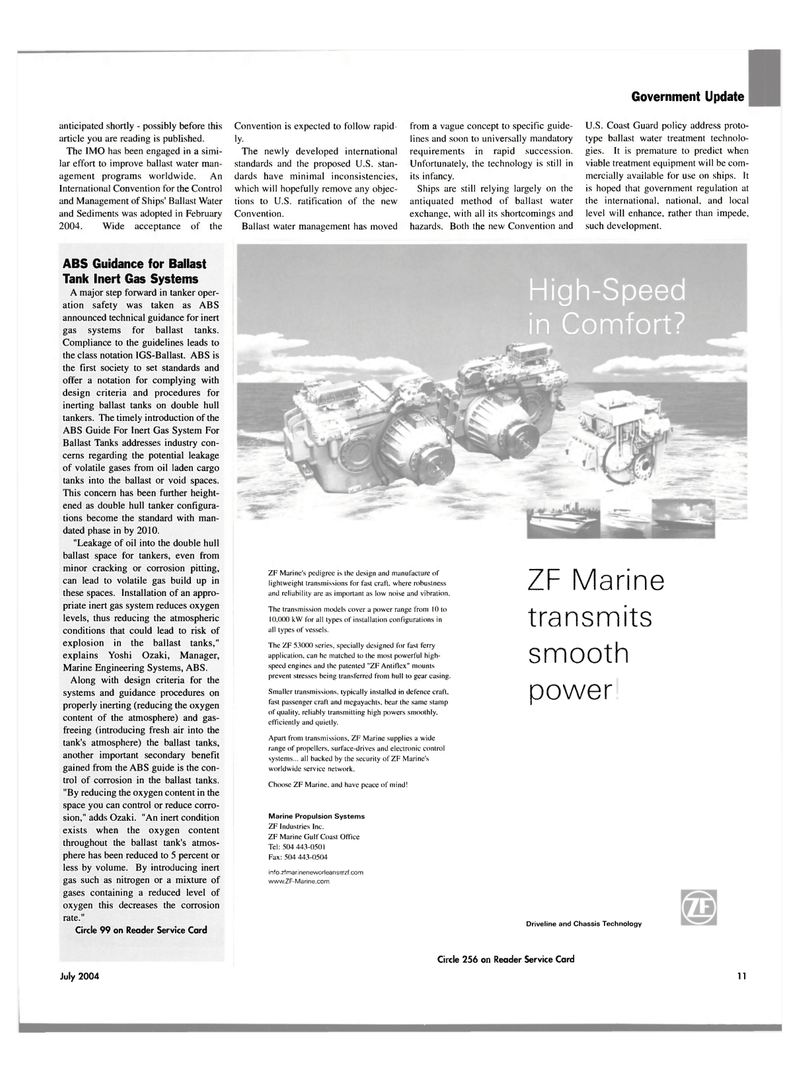
Page 11: of Maritime Reporter Magazine (July 2004)
Gulf of Mexico: Floating Production Systems & Support Vessels
Read this page in Pdf, Flash or Html5 edition of July 2004 Maritime Reporter Magazine
Government Update anticipated shortly - possibly before this article you are reading is published.
The IMO has been engaged in a simi- lar effort to improve ballast water man- agement programs worldwide. An
International Convention for the Control and Management of Ships' Ballast Water and Sediments was adopted in February 2004. Wide acceptance of the
ABS Guidance for Ballast
Tank Inert Gas Systems
A major step forward in tanker oper- ation safety was taken as ABS announced technical guidance for inert gas systems for ballast tanks.
Compliance to the guidelines leads to the class notation IGS-Ballast. ABS is the first society to set standards and offer a notation for complying with design criteria and procedures for inerting ballast tanks on double hull tankers. The timely introduction of the
ABS Guide For Inert Gas System For
Ballast Tanks addresses industry con- cerns regarding the potential leakage of volatile gases from oil laden cargo tanks into the ballast or void spaces.
This concern has been further height- ened as double hull tanker configura- tions become the standard with man- dated phase in by 2010. "Leakage of oil into the double hull ballast space for tankers, even from minor cracking or corrosion pitting, can lead to volatile gas build up in these spaces. Installation of an appro- priate inert gas system reduces oxygen levels, thus reducing the atmospheric conditions that could lead to risk of explosion in the ballast tanks," explains Yoshi Ozaki, Manager,
Marine Engineering Systems, ABS.
Along with design criteria for the systems and guidance procedures on properly inerting (reducing the oxygen content of the atmosphere) and gas- freeing (introducing fresh air into the tank's atmosphere) the ballast tanks, another important secondary benefit gained from the ABS guide is the con- trol of corrosion in the ballast tanks. "By reducing the oxygen content in the space you can control or reduce corro- sion," adds Ozaki. "An inert condition exists when the oxygen content throughout the ballast tank's atmos- phere has been reduced to 5 percent or less by volume. By introducing inert gas such as nitrogen or a mixture of gases containing a reduced level of oxygen this decreases the corrosion rate."
Circle 99 on Reader Service Card
Convention is expected to follow rapid- iy-
The newly developed international standards and the proposed U.S. stan- dards have minimal inconsistencies, which will hopefully remove any objec- tions to U.S. ratification of the new
Convention.
Ballast water management has moved from a vague concept to specific guide- lines and soon to universally mandatory requirements in rapid succession.
Unfortunately, the technology is still in its infancy.
Ships are still relying largely on the antiquated method of ballast water exchange, with all its shortcomings and hazards. Both the new Convention and
U.S. Coast Guard policy address proto- type ballast water treatment technolo- gies. It is premature to predict when viable treatment equipment will be com- mercially available for use on ships. It is hoped that government regulation at the international, national, and local level will enhance, rather than impede, such development.
High-Speed in Comfort?
ZF Marine's pedigree is the design and manufacture of lightweight transmissions for fast craft, where robustness and reliability are as important as low noise and vibration.
The transmission models cover a power range from 10 to 10.000 kW for all types of installation configurations in all types of vessels.
The ZF 53000 series, specially designed for fast ferry application, can he matched to the most powerful high- speed engines and the patented "ZF Antiflex" mounts prevent stresses being transferred from hull to gear casing.
Smaller transmissions, typically installed in defence craft, fast passenger craft and megayachts. bear the same stamp of quality, reliably transmitting high powers smoothly, efficiently and quietly.
Apart from transmissions. ZF Marine supplies a wide range of propellers, surface-drives and electronic control systems... all backed by the security of ZF Marine's worldwide service network.
Choose ZF Marine, and have peace of mind!
ZF Marine transmits smooth power
Marine Propulsion Systems
ZF Industries Inc.
ZF Marine Gulf Coast Office
Tel: 504 443-0501
Fax: 504 443-0504 info.zfmarineneworleans y'zf.com www.ZF-Marine.com
Driveline and Chassis Technology
Circle 256 on Reader Service Card
July 2004 11

 10
10

 12
12
